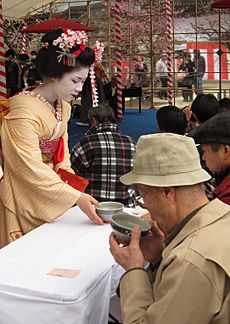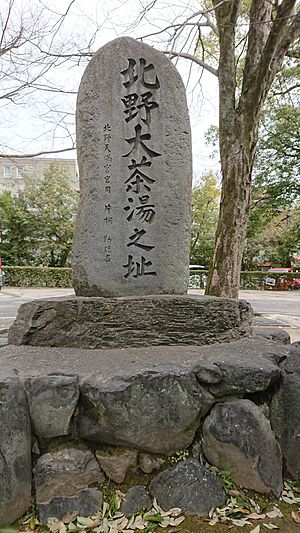Grand Kitano Tea Ceremony facts for kids
The Grand Kitano Tea Ceremony (Japanese: 北野大茶湯; Kitano ōchanoyu) was a huge Japanese tea ceremony event. It was held by Toyotomi Hideyoshi, a powerful leader, at the Kitano Tenmangū shrine in Kyoto. This special gathering happened on October 1, 1587.
Historians see it as a very important cultural event from the Momoyama period in Japan. It helped Hideyoshi show his power and cultural knowledge. It also changed how tea ceremonies were done. Plus, it showed some tension between Hideyoshi and his main tea master, Sen no Rikyū.
Contents
Why Was This Tea Party So Important?
Hideyoshi's Rise to Power
Toyotomi Hideyoshi started from a humble background. He became the ruler of Japan. He believed that knowing about culture was just as important as having a strong army. So, he started practicing chanoyu, the Japanese tea ceremony. This helped him show he was a refined and legitimate leader.
Other rulers before him, like Oda Nobunaga, also used tea ceremonies this way. Hideyoshi followed Nobunaga, who was trying to reunite Japan. To look like true rulers, both Nobunaga and Hideyoshi collected famous artworks. Many of these art pieces had belonged to earlier rulers.
Nobunaga often received these art treasures from warlords and merchants. He also took them from enemies he defeated. Nobunaga even used chanoyu as a way to manage his military commanders. He would give them valuable tea art as rewards for good service. He also controlled who could practice tea ceremonies.
Hideyoshi Takes Charge
After Nobunaga's sudden death in 1582, Hideyoshi quickly took control. He continued Nobunaga's plans. He also took possession of Nobunaga's cherished tea art. These items showed his new wealth and cultural standing. Later that year, Hideyoshi asked Nobunaga's top tea advisors to work for him. These advisors included Sen no Rikyū, Tsuda Sōgyū, and Imai Sōkyū.
Grand Events to Show Authority
The Grand Kitano Tea Gathering was one of many big events Hideyoshi organized. He used these events to gain respect and show his cultural authority.
- In 1583, he celebrated the opening of his new Osaka Castle. The ceremonies lasted for days. Tea masters and warlords attended. Generals gave him tea art as gifts.
- In 1585, he held a huge event at Daitoku-ji temple. This temple was a center of Zen Buddhism. Many people who practiced tea ceremonies trained there. The event included tea practitioners, merchants, monks, and Hideyoshi's commanders. Hideyoshi displayed his art collection at the temple.
- In 1587, Hideyoshi won a big battle in Kyūshū. He celebrated with tea gatherings in Hakata. Wealthy merchants hosted these events.
Just two weeks after returning to Osaka from his victory, Hideyoshi announced the Grand Kitano Tea Gathering.
Who Could Attend and How It Worked
The Big Announcement
Around July 1587, signs announcing the event went up in Kyoto, Sakai, Nara, and other cities. These places had many tea ceremony fans. A famous tea record book, the Matsuya Kaiki, copied the text from one of these signs.
The sign said:
- What: A Grand Tea Ceremony would be held at Kitano grove. It would start on October 1 and last for ten days, if the weather was good.
- Why: Hideyoshi would display his most famous tea items. This was so all tea lovers could see them.
- Who: Everyone was invited! This included warriors' helpers, townspeople, farmers, and even those of lower social status.
- What to Bring: Participants should bring a kettle, a water bucket, a tea bowl, and tea. If they didn't have tea, powdered roasted rice (kogashi) was fine.
- Setting Up: Since it was in a pine grove, a small space (about two tatami mats) was good for setting up. People who liked the simple wabi style could just use mat-covers or rice-hull bags. Everyone could arrange their space as they wished.
- Global Invitation: The invitation was not just for people in Japan. It was for anyone who loved tea, even people from other countries.
- Longer Event: Hideyoshi extended the event beyond the first day. This was so people from far away could see his treasures.
- For Wabi People: Hideyoshi made these plans especially for wabi people. Wabi means a simple, quiet, and rustic style. Anyone who loved wabi but didn't attend would be forbidden from preparing tea (even kogashi) later. Anyone who visited such a person would also be punished.
- Hideyoshi's Promise: Hideyoshi said he would personally prepare tea for all wabi people, even those from distant places.
About a month before the event, Hideyoshi invited nobles in Kyoto to join. He also ordered a wealthy merchant from Hakata, Kamiya Sōtan, to attend. Kamiya Sōtan was the only one from Kyūshū invited.
A Gathering for Everyone
It was very special that this event was open to everyone, no matter their social rank or wealth. Hideyoshi had his own tea venue. His three main tea masters also hosted venues. These masters were important merchants from the city of Sakai. Their venues were major attractions.
According to a diary kept by a nobleman named Yoshida Kanemi, the Kitano Tenmangū shrine's bamboo grove was packed. By September 28, 1587, there were over 800 tea houses and spaces for serving tea. By September 30, the day before the event, about 1,500 to 1,600 tea venues were set up.
Among the participants were Hideyoshi's three tea masters: Sen no Rikyū, Tsuda Sōgyū, and Imai Sōkyū. Nobles and warriors also attended. Each host set up a station to serve tea to small or larger groups. The famous Golden Tea Room was also set up in the shrine gardens.
The event was planned to last ten days. However, for reasons unknown, Hideyoshi ended it after only one day.
Annual Plum Blossom Festival

Based on this historic event, the shrine holds a yearly Plum Blossom Festival (梅花祭, baikasai). It takes place on February 25. During the festival, about 3,000 guests are served tea and traditional Japanese sweets (wagashi). Geisha and maiko serve the guests.
In Popular Media
Hyouge Mono (へうげもの Hepburn: Hyōge Mono, lit. "Jocular Fellow") is a Japanese manga series. It was written and illustrated by Yoshihiro Yamada. In 2011, it was made into an anime series. The story includes the Grand Kitano Tea Ceremony.
Recommended Reading
- Cort, Louise. "The Grand Kitano Tea Gathering," Chanoyu Quarterly no. 31, pp. 15-44. (Urasenke Foundation, Kyoto, 1982: ISSN-0009-1537)


